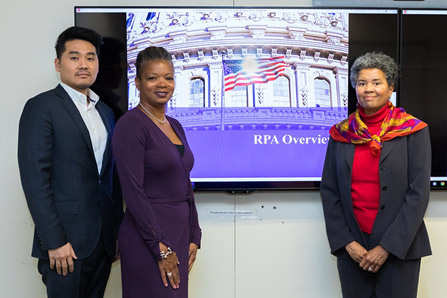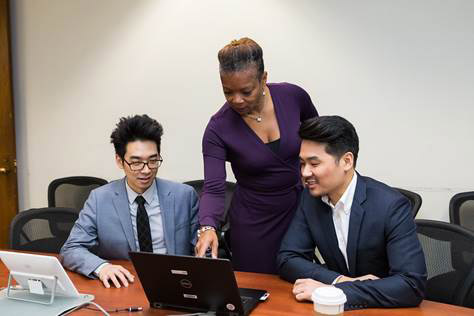

Planting the Seeds to an Innovative Future

Ryan Jeun, Director, Job Corps Budget Division with Adrienne Young,
OFA’s Comptroller,
and Rachelle Coleman, CGFM, CPA, Chief, Internal Control, Risk Management
& Systems Division of the U.S. Department of Labor, ETA
A presentation could generate an idea. An idea could potentially incite a “seed” being planted. That seed could grow into a project implementation. That implementation can transform and streamline the agency’s workforce performance.
Over the last few years, the Office of Financial Innovation and Transformation (FIT), under the Bureau of the Fiscal Service, worked with various government agencies to better understand and use transformative technologies, through their piloting programs. One such technology, Robotics Processing Automation (RPA), has proved beneficial for the Fiscal Service. RPA software, referred to as a “bot”, can be thought of as a digital employee. Different licensing agreements may define bots slightly differently, but, one bot equals 24 hours of time to perform tasks.
In an internal eight-month pilot project, FIT developed RPA to speed financial processes for entering data, scraping e-mail, reconciling information between systems and validating forms. “Through the pilot, we were able to improve processing times and accuracy through automation,” said Craig Fischer, FIT’s Innovation Program Manager. “We were able to defer a lot of person-hours working on manual processes to higher-value activities.”
With the success of other agencies using RPA, FIT started to acknowledge its success and promote their innovations at various places, including events. “FIT was starting to help agencies plant innovative seeds in their organizations and help with their growth into fruitful projects, such as RPA,” said Jennifer Hill, FIT’s Program and Management Analyst.
Presenting an idea to Grow

Adrienne Young shows Kenji Aimoto, Financial Management Specialist,
and Ryan Jeun how automation is improving the Job Corp transactions.
During the 2018 Government Financial Management Conference (GFMC), the agency presented a session about their first pilot. Little did they know, there were eyes watching and ears listening. Fast forward to June 2019, at the Federal RPA Community of Practice (CoP) Kick-off Meeting, FIT met with those eyes and ears - the Department of Labor (DOL), Employment and Training Administration (ETA), Office of Financial Administration (OFA) and through a conversation, discovered that the agency is implementing a RPA pilot program.
“The RPA session at the GFMC delivered a rich insight to how an innovative solution is improving federal financial management,” said Rachelle Coleman, CGFM, CPA, Chief, Internal Control, Risk Management & Systems Division of the U.S. Department of Labor, ETA. “After the presentation, I met with other agencies, and discussed with them about embracing bots, and it sparked an idea. I also met with Adrienne Young, OFA’s Comptroller, to update her on the presentation. OFA’s Comptroller shared her interest in RPA and her plans to consider RPA for the Job Corps Travel Card. A few months later, ETA’s team was inspired to start a journey of piloting RPA in the Job Corps program.”
Job Corps is the largest free residential education and job training program administered by DOL that helps at-risk young people ages 16-24 connect the skills and education for the career they want. It has trained and educated over two million individuals since 1964. Today, there are 121 Job Corps centers, mainly residential, in 50 states, the District of Columbia, and the Commonwealth of Puerto Rico.
As one of the largest programs at DOL, developing an RPA pilot plan might be a lot to handle, so they decided on one of its financial components – the Job Corps Travel Card.
“There are areas with the Job Corps financial processes and controls that could be improved with automation,” says Adrienne Young, OFA Comptroller. “We believe RPA can do the work of reconciling the costs associated with student travel using a more efficient and streamlined process than we have now.”
The launch of an emerging seed
Even though the DOL, ETA, OFA recently finished developing ETA’s first bot, it is already making plans to consult with a contractor to identify other areas where technology would help streamline processes. The thousands of transactions that happen daily take many days to process. Bots would be able to manage those transactions in a few minutes, allowing Job Corps staff to more mission-based work.
In 2019, Ryan Jeun, Director, Job Corps Budget Division, stated “Right now, the transactional review of the Job Corps Travel Card is very manual. Using an emerging technology, such as RPA to pilot this program will benefit the Job Corps in four ways: It will 1. Modernize the program’s effectiveness, 2. Provide our employees more time to be innovative. 3. Link our students to more career possibilities and 4. Introduce RPA to other areas in the DOL. I would definitely say that automation in any effort is a win-win for our agency.”
In the end as the Federal Government becomes more customer-centric, the need to create and maintain the conditions that make innovation happen is imperative. A presentation about an emerging technology from one agency set forth an idea in another and started a cutting-edge culture that will benefit Job Corps from the ground up. For both agencies, it's the formula for a bountiful transformation.
Sign-up with FIT to keep track of new innovative stories about federal agencies joining forces with technology which we report about in our blog series. Stay tuned!
To find out more about the Fiscal Service, visit fiscal.treasury.gov or follow us on LinkedIn, Twitter and Facebook.
